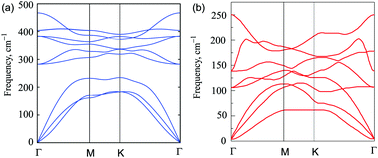Tailoring the structural and electronic properties of an SnSe2/MoS2 van der Waals heterostructure with an electric field and the insertion of a graphene sheet†
Abstract
van der Waals heterostructures (vdWHs), obtained by vertically stacking different two-dimensional (2D) layered materials are being considered intensively as potential materials for nanoelectronic and optoelectronic devices because they can show the most potential advantages of individual 2D materials. Here, we construct the SnSe2/MoS2 vdWH and investigate its electronic and optical properties using first-principles calculations. We find that the band structures of both MoS2 and SnSe2 monolayers are well kept in the SnSe2/MoS2 vdWH because of their weakly interacting features via vdW interaction. The SnSe2/MoS2 vdWH forms a type-I band alignment and exhibits an indirect semiconductor band gap of 0.45 eV. The type-I band alignment makes the SnSe2/MoS2 vdWH a promising material for optoelectronic nanodevices, such as light emitting diodes because of ultra-fast recombination of electrons and holes. Moreover, the band gap and band alignment of the SnSe2/MoS2 vdWH can be tailored by the electric field and the insertion of a graphene sheet. After applying an electric field, type-I to type-II and semiconductor to metal transitions can be achieved in the SnSe2/MoS2 vdWH. Besides, when a graphene sheet is inserted into the SnSe2/MoS2 vdWH to form three stacking types of G/SnSe2/MoS2, SnSe2/G/MoS2 and SnSe2/MoS2/G, the p-type semiconductor of the SnSe2/MoS2 vdWH is converted to an n-type Ohmic contact. These findings provide theoretical guidance for designing future nanoelectronic and optoelectronic devices based on the SnSe2/MoS2 vdWH.



 Please wait while we load your content...
Please wait while we load your content...